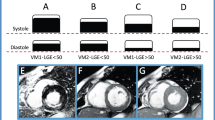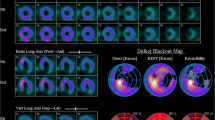Abstract
Coronary artery bypass grafting improves survival in patients with ischemic cardiomyopathy, however, these patients are at high risk for morbidity and mortality. The role of viability testing to guide revascularization in these patients is unclear. Cardiac magnetic resonance imaging (CMR) has not been studied adequately in this population despite being considered a reference standard for infarct imaging. We performed a multicenter retrospective analysis of patients (n = 154) with severe left ventricular systolic dysfunction [ejection fraction (EF) < 35%] on CMR who underwent CMR viability assessment prior to consideration for revascularization. Using the AHA16-segment model, percent total myocardial viability was determined depending on the degree of transmural scar thickness. Patients with or without revascularization had similar clinical characteristics and were prescribed similar medical therapy. Overall, 43% of patients (n = 66) experienced an adverse event during the median 3 years follow up. For the composite outcome (death, myocardial infarction, heart failure hospitalization, stroke, ventricular tachycardia) patients receiving revascularization were less likely to experience an adverse event compared to those without revascularization (HR 0.53, 95% CI 0.33–0.86, p = 0.01). Patients with > 50% viability on CMR had a 47% reduction in composite events when undergoing revascularization opposed to medical therapy alone (HR 0.53, p = 0.02) whereas patients with a viability < 50% were 2.7 times more likely to experience an adverse event (p = 0.01). CMR viability assessment may be an important tool in the shared decision-making process when considering revascularization options in patients with severe ischemic cardiomyopathy.




Similar content being viewed by others
References
Yancy CW, Jessup M, Bozkurt B, American College of Cardiology Foundation/American Heart Association Task Force on Practice Guidelines et al (2013) 2013 ACCF/AHA guideline for the management of heart failure: a report of the American College of Cardiology Foundation/American Heart Association Task Force on practice guidelines. Circulation 128(16):e240–e327
Velazquez EJ, Lee KL, Deja MA, Jain A, Sopko G, Marchenko A, Ali IS, Pohost G, Gradinac S, Abraham WT, Yii M, Prabhakaran D, Szwed H, Ferrazzi P, Petrie MC, O’Connor CM, Panchavinnin P, She L, Bonow RO, Rankin GR, STICH Investigators (2011) Coronary-artery bypass surgery in patients with left ventricular dysfunction. N Engl J Med 364(17):1607–1616
Velazquez EJ, Lee KL, Jones RH, Al-Khalidi HR, Hill JA, Panza JA, Michler RE, Bonow RO, Doenst T, Petrie MC, Oh JK, She L, Moore VL, Desvigne-Nickens P, Sopko G, Rouleau JL, STICHES Investigators (2016) Coronary-artery bypass surgery in patients with ischemic cardiomyopathy. N Engl J Med 374(16):1511–1520
Petrie MC, Jhund PS, She L, STICH Trial Investigators et al (2016) Ten-year outcomes after coronary artery bypass grafting according to age in patients with heart failure and left ventricular systolic dysfunction: an analysis of the extended follow-up of the STICH Trial (Surgical Treatment for Ischemic Heart Failure). Circulation 134(18):1314–1324
Kim RJ, Fieno DS, Parrish TB, Harris K, Chen EL, Simonetti O, Bundy J, Finn JP, Klocke FJ, Judd RM (1999) Relationship of MRI delayed contrast enhancement to irreversible injury, infarct age, and contractile function. Circulation 100(19):1992–2002
Kim RJ, Wu E, Rafael A, Chen EL, Parker MA, Simonetti O, Klocke FJ, Bonow RO, Judd RM (2000) The use of contrast-enhanced magnetic resonance imaging to identify reversible myocardial dysfunction. N Engl J Med 343(20):1445–1453
Wagner A, Mahrholdt H, Holly TA, Elliott MD, Regenfus M, Parker M, Klocke FJ, Bonow RO, Kim RJ, Judd RM (2003) Contrast-enhanced MRI and routine single photon emission computed tomography perfusion imaging for detection of subendocardial myocardial infarcts: an imaging study. Lancet 361:374–379
Cox DR, Oakes D (1984) Analysis of survival data. Chapman and Hall, London, New York, 201 S., £ 12. Biom J 29:114–114. https://doi.org/10.1002/bimj.4710290119
Schinkel AF, Bax JJ, Poldermans D, Elhendy A, Ferrari R, Rahimtoola SH (2007) Hibernating myocardium: diagnosis and patient outcomes. Curr Probl Cardiol 32(7):375–410
Kim RJ, Shah DJ (2004) Fundamental concepts in myocardial viability assessment revisited: when knowing how much is “alive” is not enough. Heart (Br Card Soc) 90(2):137–140
Kwon DH, Obuchowski NA, Marwick TH, Menon V, Griffin B, Flamm SD, Hachamovitch R (2018) Jeopardized myocardium defined by late gadolinium enhancement magnetic resonance imaging predicts survival in patients with ischemic cardiomyopathy: impact of revascularization. J Am Heart Assoc 7(22):e009394
Allman KC, Shaw LJ, Hachamovitch R, Udelson JE (2002) Myocardial viability testing and impact of revascularization on prognosis in patients with coronary artery disease and left ventricular dysfunction: a meta-analysis. J Am Coll Cardiol 39(7):1151–1158
Ling LF, Marwick TH, Flores DR, Jaber WA, Brunken RC, Cerqueira MD, Hachamovitch R (2013) Identification of therapeutic benefit from revascularization in patients with left ventricular systolic dysfunction: inducible ischemia versus hibernating myocardium. Circ Cardiovasc Imaging 6(3):363–372
Mc Ardle B, Shukla T, Nichol G, deKemp RA, Bernick J, Guo A, Lim SP, Davies RA, Haddad H, Duchesne L, Hendry P, Masters R, Ross H, Freeman M, Gulenchyn K, Racine N, Humen D, Benard F, Ruddy TD, Chow BJ, PARR-2 Investigators (2016) Long-term follow-up of outcomes with F-18-fluorodeoxyglucose positron emission tomography imaging-assisted management of patients with severe left ventricular dysfunction secondary to coronary disease. Circ Cardiovasc Imaging 9(9):e004331
Inaba Y, Chen JA, Bergmann SR (2010) Quantity of viable myocardium required to improve survival with revascularization in patients with ischemic cardiomyopathy: a meta-analysis. J Nucl Cardiol 17:646–654. https://doi.org/10.1007/s12350-010-9226
Bonow RO, Maurer G, Lee KL, Holly TA, Binkley PF, Desvigne-Nickens P, Drozdz J, Farsky PS, Feldman AM, Doenst T, Michler RE, Berman DS, Nicolau JC, Pellikka PA, Wrobel K, Alotti N, Asch FM, Favaloro LE, She L, Velazquez EJ, STICH Trial Investigators (2011) Myocardial viability and survival in ischemic left ventricular dysfunction. N Engl J Med 364(17):1617–1625
Kwon DH, Halley CM, Carrigan TP, Zysek V, Popovic ZB, Setser R, Schoenhagen P, Starling RC, Flamm SD, Desai MY (2009) Extent of left ventricular scar predicts outcomes in ischemic cardiomyopathy patients with significantly reduced systolic function: a delayed hyperenhancement cardiac magnetic resonance study. JACC Cardiovasc Imaging 2(1):34–44
Gerber BL, Rousseau MF, Ahn SA, le Polain de Waroux JB, Pouleur AC, Phlips T, Vancraeynest D, Pasquet A, Vanoverschelde JL (2012) Prognostic value of myocardial viability by delayed-enhanced magnetic resonance in patients with coronary artery disease and low ejection fraction: impact of revascularization therapy. J Am Coll Cardiol 59(9):825–835
Funding
This research was supported by a grant provided by the Cardiovascular Research Institute at Loyola University Medical Center, Maywood, Illinois.
Author information
Authors and Affiliations
Corresponding author
Ethics declarations
Conflict of interest
There are no conflicts of interest for any of the authors.
Additional information
Publisher's Note
Springer Nature remains neutral with regard to jurisdictional claims in published maps and institutional affiliations.
Rights and permissions
About this article
Cite this article
Doukas, D., Porcaro, K., Marot, J. et al. Clinical characteristics and outcomes of patients with severe left ventricular dysfunction undergoing cardiac MRI viability assessment prior to revascularization. Int J Cardiovasc Imaging 37, 675–684 (2021). https://doi.org/10.1007/s10554-020-02042-w
Received:
Accepted:
Published:
Issue Date:
DOI: https://doi.org/10.1007/s10554-020-02042-w




